Streamlined Dive Gear: A Huge Diving Performance Boost
Streamlined dive gear is a critical factor in making overall improvements to your comfort and control in the water. Scuba divers should consider streamlined dive gear to be a high priority when purchasing and configuring their equipment for diving.
This article explains the benefits of streamlined scuba equipment, along with how to assess your streamlining and some tips to improve it.
The benefits of streamlined dive gear
Streamlined scuba equipment, in conjunction with proper horizontal trim and correct weighting, will reduce exertion. In turn, that helps to improve your air consumption.
The diver should critically examine their configuration with the aim of reducing their overall ‘profile’ in the water.
- Minor tweaks and adjustments can have a big impact when combined.
- Every small adjustment adds up to an overall noticeable improvement.
In addition, streamlined scuba equipment is critical for divers who wish to enter enclosed areas. In activities like wreck or cave penetration entanglement poses a more significant safety hazard.
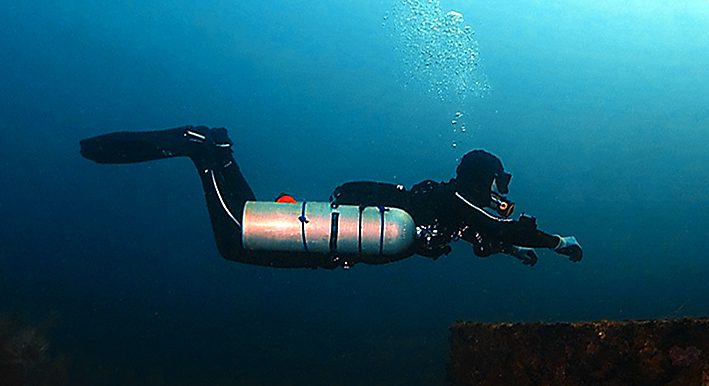
Streamlined dive gear and entanglement hazards
Even general open-water divers should be aware of entanglement risks. For instance, any dive sites may have monofilament fishing lines, nets or kelp that can get caught in non-streamlined scuba equipment.
Streamlined dive gear and task loading
Another issue with a badly configured and/or unnecessary scuba kit is that it increases task loading. This can be especially important if the diver ever encounters an emergency that requires a fast response.
Dive gear that dangles around the diver’s body will interfere with that fast response. In turn, that can serve to promote increase diver stress.
Tangled and dangling equipment can also significantly hamper diver rescue situations. It interferes with the swift removal of equipment from the scuba diver.
- A properly streamlined diver should have no item of equipment projecting, or dangling, from them.
- They will have considered the necessity and design of the equipment they choose to carry.
- In addition, they will have devised stowage solutions that keeps everything secure and unobtrusive.
Assessing streamlined scuba equipment from a critical perspective
Streamlined dive gear: Hose configuration
Hoses should be sized and routed so that they are flush with the body. They shouldn’t be projecting at all angles and have a surplus length that causes them to ‘bow’ outwards.
- Start with an assessment of your regulator 1st stage and be aware of how the hose ports are located.
- Attach your first stage so that the location of the hose ports allows the hoses to be routed close to the body.
- You can obtain right-angled hose adaptors to help with your routing if required.
- If a hose on your regulator is longer than you require it, then buy a more appropriately sized hose.
- Many divers are not aware that hoses are sold in a variety of lengths and materials;
- rubber, flexible Kevlar, stainless steel braided etc.
Streamlined dive gear: Dangling accessories
Carrying too many novelty gadgets is a common novice diver mistake. It often results in a novice diver being labeled as a ‘Christmas Tree Diver’.
Enthusiastic novice divers are often tempted to purchase every available gadget from their local dive shop shelves. Then they transfer it onto their person by means of;
- Lanyards
- Retractors
- Quick-release buckles
- Nylon bands, carabineers
- ‘Telephone cable’ retainers.
At the very least, these are distracting for the diver. At worst, they pose safety hazards.
- Don’t carry stuff that isn’t needed.
- Research the appropriate gear for the diving that you will be doing.
- Understand that the need for redundancy has to be balanced against the risk and likelihood of primary equipment failure.
- Think about kit choices carefully and with an integrated, multi-functional approach.
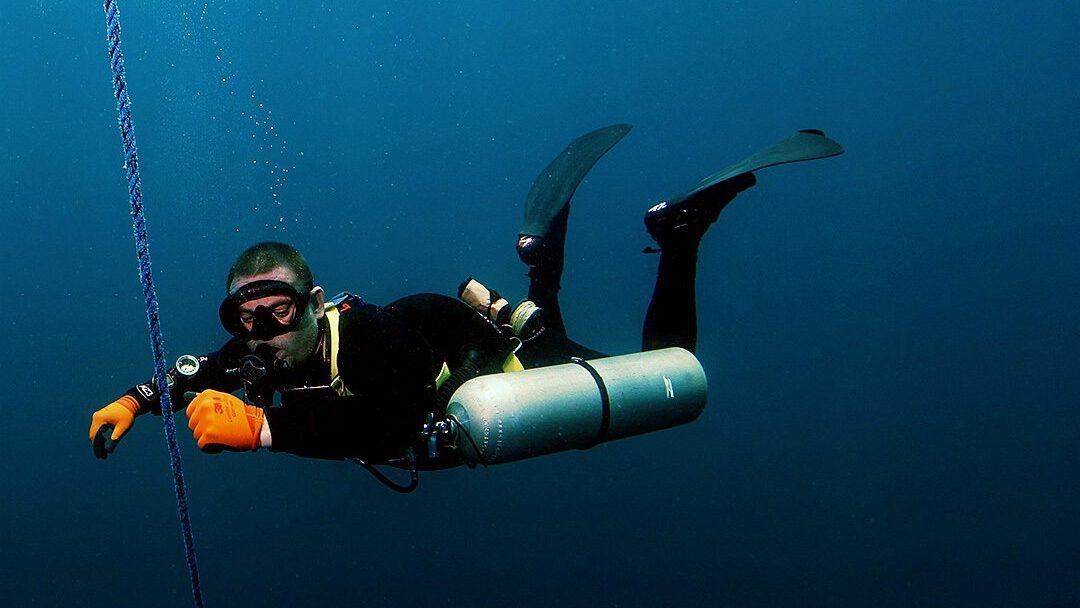
Where equipment is needed – make sure it is stowed in pockets, not hanging off d-rings like an underwater Christmas tree. ‘
- Replace fancy retractors with solid, reliable, low-profile bolt snaps.
- Consider putting thigh pockets onto your wetsuit or dry suit for storage.
- There is no need to strap a Rambo-sized knife to the calf.
- A 2” titanium knife attached directly to your BCD is far more convenient and practical.
As a general rule, ‘less is more’. A minimalist approach to diving configuration and equipment will pay dividends to the efficiency and economy of the diver.
Streamlined dive gear: Alternate Air Source (AAS)
There’s simply no excuse for a dangling AAS. Not only is this bad streamlining, but it also impacts the possible success of emergency procedures.
Stow the AAS securely and close to your torso. There are many effective ways to do this; and also, many very ineffective ways that normally involve ‘clever’ gadget clips.
An Economical Method To Secure AAS Streamlined
- One simple solution is to utilize a simple rubber ‘snorkel holder’.
- This figure-of-8-shaped piece of rubber can be threaded through itself on any D-ring attachment point.
- The mouthpiece of the regulator then fits securely into the open loop of the holder.
- These cost about 50 cents and do a better job than most, far more expensive, AAS holders.
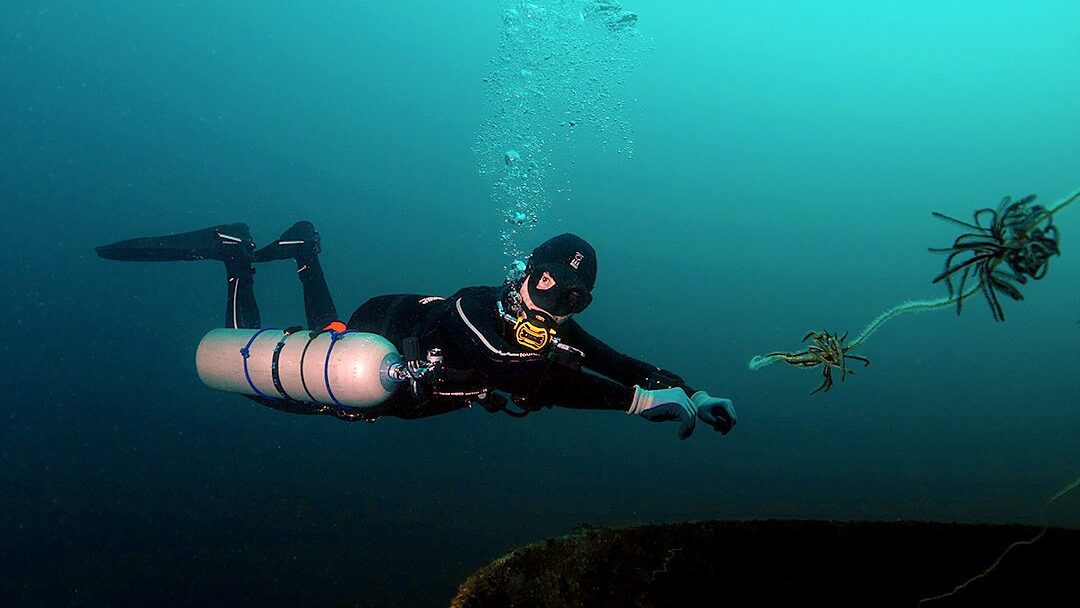
Use a Bungee Necklace
- Another solution that is very popular with technical, cave, wreck and other advanced divers is to secure the AAS close to their chin, using a ‘bungee necklace’.
- This is simply an appropriate length of bungee cord that is made into a ‘necklace’ that holds the AAS mouthpiece under the diver’s chin.
- It can be designed to allow the donation of the AAS in an emergency or to be permanently attached if the diver chooses to donate their primary regulator and keep their AAS for themselves.
- Either design requires nothing more than 2 knots and a couple of tie-wraps.
Streamlined dive gear: Submersible Pressure Gauge (SPG)
Again, there’s no excuse for a dangling SPG.
- A few dollars will buy a marine stainless steel bolt snap that can be tied securely to the SPG with some cave/reel line.
- The SPG can then be clipped securely to any attachment point (most commonly a hip or shoulder D-ring).
SPG hoses are often far longer than required. Consider getting a 24” SPG hose, which will be sufficient for most divers to route the SPG to their hip, or under their arm to their chest.
Streamlined dive gear: Essential tips
Streamlined dive gear: Use bolt snaps
Piston design, marine stainless steel, and bolt snaps are used to create a robust method of securing ancillaries; without risk of entanglement, accidental loss, or excess bulk.
This is a highly popular solution, favored by the technical and cave diving communities – which have lots of ancillaries to carry and need a simple, rugged method of attachment/stowage. They don’t break, they don’t cost very much and they do the job perfectly.
Attach the kit to the clips with a little bit of cave line (the same line you have on your reel), with a cave knot (directions for tying this knot are contained on our website’s resources page). This is simple and effective storage, but you can cut items free in an emergency (i.e. if tangled up).
For torches and other expensive items, the diver can put/leave a wrist loop on the torch. When deploying, the hand goes through the loop, before unclipping the snap. It cannot then be easily lost. Do the same in reverse to store it.
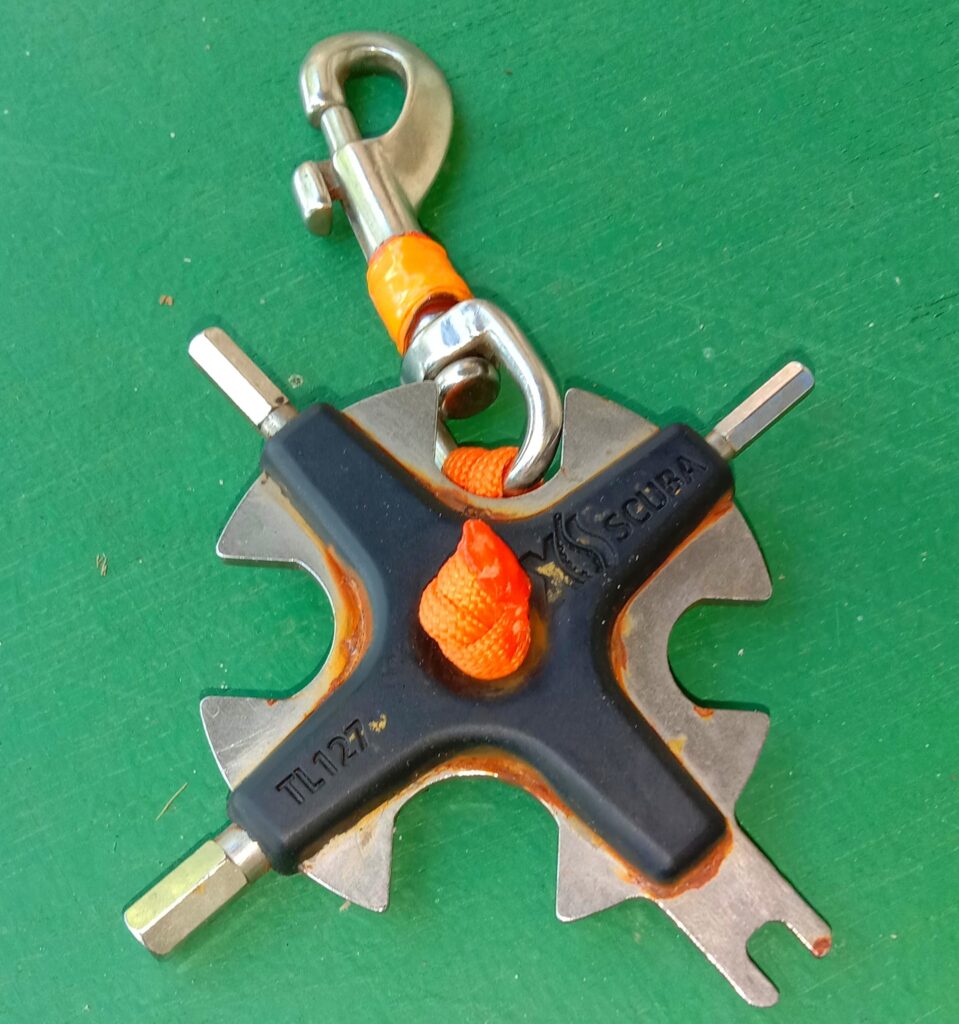
Streamlined dive gear: Avoid using ‘Suicide Clips’
Suicide clips are the name given to an attachment device that doesn’t require positive input from the diver to attach something; for instance spring-gate carabineers.
These devices only require a brief contact to accidentally ensnare and entangle the diver against ropes, wire, line, netting or kelp that they may swim into when diving.
Avoiding this type of attachment is especially important for diving in wrecks, where confined spaces, silt and the presence of many lines, wires and nets pose considerable entanglement safety hazards.
They are called ‘suicide clips‘ for a reason – experienced divers (especially those who dive in wrecks and caves) know that these clips have caused fatal incidents!
Streamlined dive gear: Bungee loops in pockets
Divers often fret about losing expensive items during a scuba dive. This leads them to degrade their streamlining by resorting to cluttered ‘retractors’ or ‘curly cords’. If your existing scuba equipment has been fitted with bolt snaps, then there is a surefire way to prevent stuff from being lost.
- Simply attach some loops of bungee cord into the BCD and/or exposure suit pockets. This allows the diver to store everything in their pockets by clipping the attached bolt snaps directly to the bungee loop.
- To access that equipment underwater, they only need to pull out the whole loop, select and detach the kit needed and then return the loop (and other attached kit) back into the pocket.
- This helps prevent equipment from being accidentally dropped and also makes the process of obtaining equipment from the pockets much easier.
You shouldn’t ever drop an item that’s being held in your hand, but if that is a concern, simply wear a modest homemade ‘bracelet’ of bungee cord around your wrist.
When you need an item, un-clip its bolt-snap from the bungee loop in your pocket and transfer the bolt-snap to the bungee on your wrist. Complete security… without a cluttered mess.
Buy new gear with streamlining in mind
Reels and Spools. For instance, a 30m finger spool is just as (or more) effective and cheaper for DSMB deployment and minor wreck penetration, than a huge plastic or metal winding reel.
DSMBs. Unless surface water conditions involve very strong currents or large waves, opt for a small size DSMB (i.e. 3’ with oral inflate), rather than a 6’ semi-closed bag.
Dive Knives. Choose a 2-3” bladed BCD knife, rather than a 4-6” version. Very few recreational divers have any for a larger knife that can hammer, chisel and pry things. The primary requirement for a knife is to cut entanglements and a 2” blade is more than sufficient for this purpose.
Dive Lights. Choose a small LED torch that can run for many hours on a couple of AA or C-cell batteries. Enormous pistol-grip style torches that require 4-8 D-cell batteries are very hard to streamline/store when not actively carried/used.
Mount computers and compasses on your forearm
Most divers find it instinctive and natural to check the information that is displayed on wrist-mounted gauges. Divers who use wrist-mounted gauges are likely to check them more frequently and retain a better awareness of the information that is presented to them.
This is a reaction that they develop long before becoming divers because the vast majority of people choose to wear watches on their wrists.
A wrist-mounted gauge is much more convenient to monitor, especially when the diver may have his hands otherwise occupied (when ascending with a DSMB, or following a penetration line into a wreck).
Wrist-mounted gauges (i.e. dive computers, compasses, depth gauges or timing devices) are much more low-profile and streamlined than large multi-gauge consoles attached to the SPG hose.
The only beneficial reason to opt for a large multi-gauge console is if the diver wants to use an air-integrated dive computer. When considering the need for direct (hose, not wireless) air integration, the diver should also consider the drawbacks with respect to streamlining, weight, and convenience of use.
Further Reading To Become A Better Diver
About The Author

Andy Davis is a RAID, PADI TecRec, ANDI, BSAC, and SSI-qualified independent technical diving instructor who specializes in teaching sidemount, trimix, and advanced wreck diving courses.
Currently residing in Subic Bay, Philippines; he has amassed more than 10,000 open-circuit and CCR dives over three decades of challenging diving across the globe.
Andy has published numerous diving magazine articles and designed advanced certification courses for several dive training agencies, He regularly tests and reviews new dive gear for scuba equipment manufacturers. Andy is currently writing a series of advanced diving books and creating a range of tech diving clothing and accessories.
Prior to becoming a professional technical diving educator in 2006, Andy was a commissioned officer in the Royal Air Force and has served in Iraq, Afghanistan, Belize, and Cyprus.
In 2023, Andy was named in the “Who’s Who of Sidemount” list by GUE InDepth Magazine.
Purchase my exclusive diving ebooks!
Originally posted 2011-10-25 23:33:20.









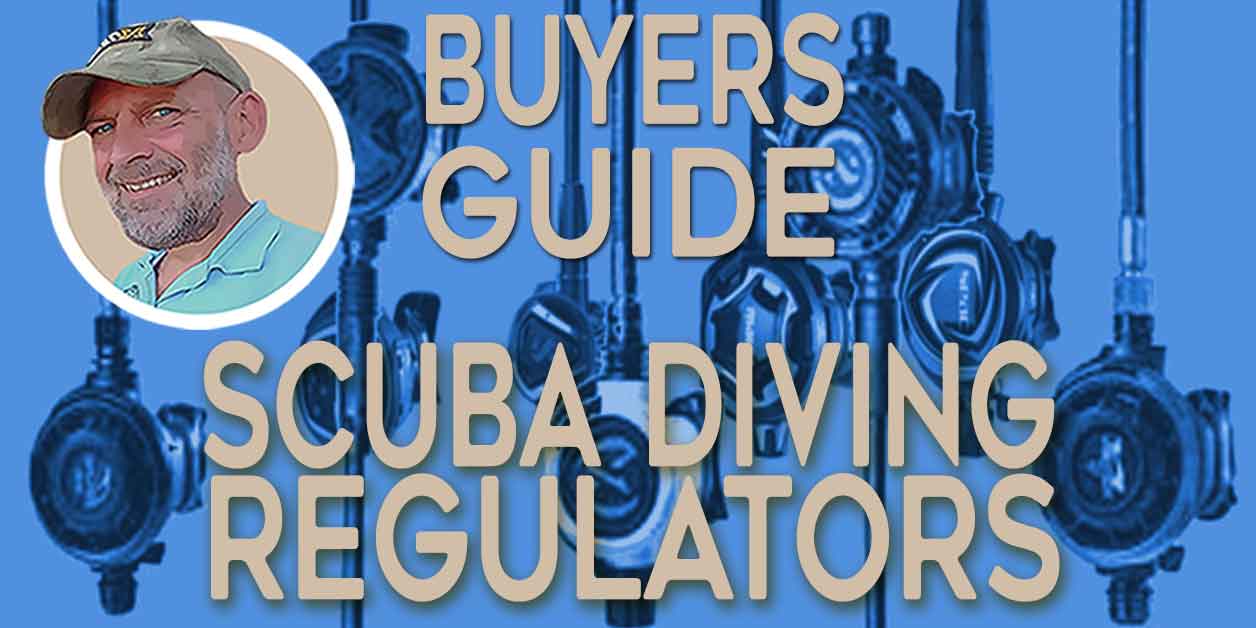
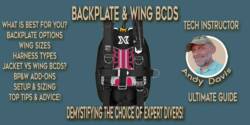
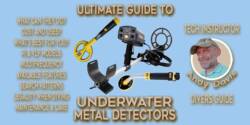


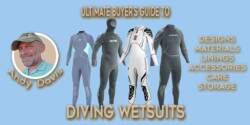
Straight to the point and well written! Why can’t everyone else be like this?
My blog is [url=http://www.businesstraveltours.com]Travel Tips[/url].